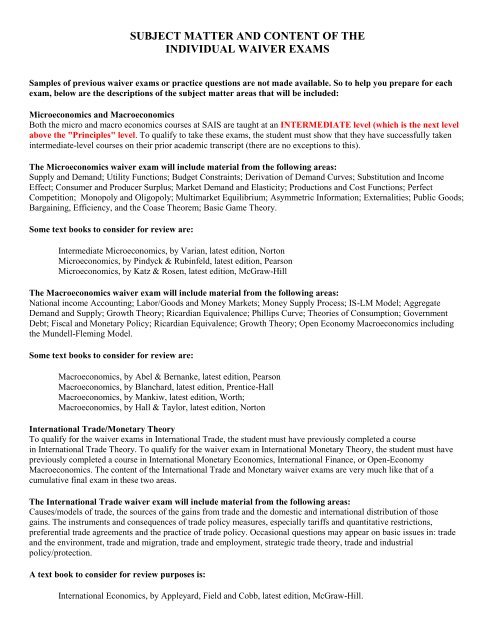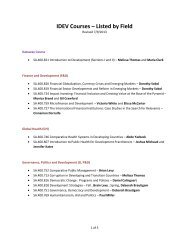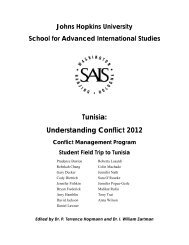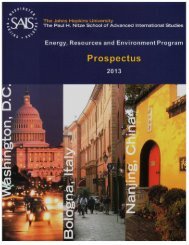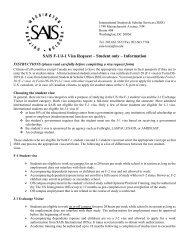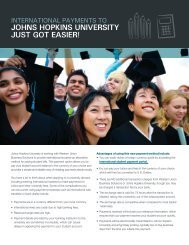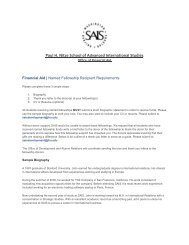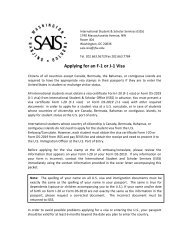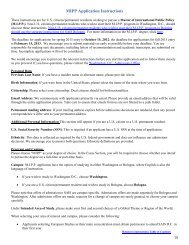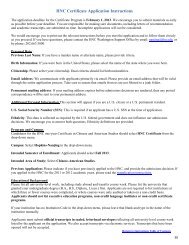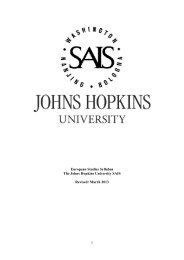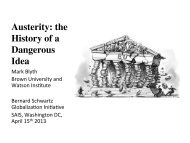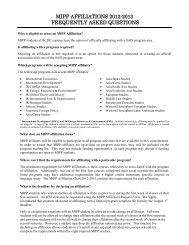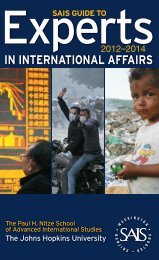SUBJECT MATTER AND CONTENT OF THE INDIVIDUAL ... - SAIS
SUBJECT MATTER AND CONTENT OF THE INDIVIDUAL ... - SAIS
SUBJECT MATTER AND CONTENT OF THE INDIVIDUAL ... - SAIS
Create successful ePaper yourself
Turn your PDF publications into a flip-book with our unique Google optimized e-Paper software.
<strong>SUBJECT</strong> <strong>MATTER</strong> <strong>AND</strong> <strong>CONTENT</strong> <strong>OF</strong> <strong>THE</strong><br />
<strong>INDIVIDUAL</strong> WAIVER EXAMS<br />
Samples of previous waiver exams or practice questions are not made available. So to help you prepare for each<br />
exam, below are the descriptions of the subject matter areas that will be included:<br />
Microeconomics and Macroeconomics<br />
Both the micro and macro economics courses at <strong>SAIS</strong> are taught at an INTERMEDIATE level (which is the next level<br />
above the "Principles" level. To qualify to take these exams, the student must show that they have successfully taken<br />
intermediate-level courses on their prior academic transcript (there are no exceptions to this).<br />
The Microeconomics waiver exam will include material from the following areas:<br />
Supply and Demand; Utility Functions; Budget Constraints; Derivation of Demand Curves; Substitution and Income<br />
Effect; Consumer and Producer Surplus; Market Demand and Elasticity; Productions and Cost Functions; Perfect<br />
Competition; Monopoly and Oligopoly; Multimarket Equilibrium; Asymmetric Information; Externalities; Public Goods;<br />
Bargaining, Efficiency, and the Coase Theorem; Basic Game Theory.<br />
Some text books to consider for review are:<br />
Intermediate Microeconomics, by Varian, latest edition, Norton<br />
Microeconomics, by Pindyck & Rubinfeld, latest edition, Pearson<br />
Microeconomics, by Katz & Rosen, latest edition, McGraw-Hill<br />
The Macroeconomics waiver exam will include material from the following areas:<br />
National income Accounting; Labor/Goods and Money Markets; Money Supply Process; IS-LM Model; Aggregate<br />
Demand and Supply; Growth Theory; Ricardian Equivalence; Phillips Curve; Theories of Consumption; Government<br />
Debt; Fiscal and Monetary Policy; Ricardian Equivalence; Growth Theory; Open Economy Macroeconomics including<br />
the Mundell-Fleming Model.<br />
Some text books to consider for review are:<br />
Macroeconomics, by Abel & Bernanke, latest edition, Pearson<br />
Macroeconomics, by Blanchard, latest edition, Prentice-Hall<br />
Macroeconomics, by Mankiw, latest edition, Worth;<br />
Macroeconomics, by Hall & Taylor, latest edition, Norton<br />
International Trade/Monetary Theory<br />
To qualify for the waiver exams in International Trade, the student must have previously completed a course<br />
in International Trade Theory. To qualify for the waiver exam in International Monetary Theory, the student must have<br />
previously completed a course in International Monetary Economics, International Finance, or Open-Economy<br />
Macroeconomics. The content of the International Trade and Monetary waiver exams are very much like that of a<br />
cumulative final exam in these two areas.<br />
The International Trade waiver exam will include material from the following areas:<br />
Causes/models of trade, the sources of the gains from trade and the domestic and international distribution of those<br />
gains. The instruments and consequences of trade policy measures, especially tariffs and quantitative restrictions,<br />
preferential trade agreements and the practice of trade policy. Occasional questions may appear on basic issues in: trade<br />
and the environment, trade and migration, trade and employment, strategic trade theory, trade and industrial<br />
policy/protection.<br />
A text book to consider for review purposes is:<br />
International Economics, by Appleyard, Field and Cobb, latest edition, McGraw-Hill.
The International Monetary waiver exam will include material from the following areas:<br />
The basic theory underlying the international monetary system. Topics include international financial markets; the<br />
macroeconomics of open economies; balance-of-payments and trade balances; exchange rates and foreign exchange<br />
markets; expectations, interests rates, capital flows; central banking and monetary policy in open economies; interaction<br />
of economies at the macro level; exchange-rate regimes; various common models of open economies under fixed and<br />
flexible exchange rates.<br />
A text book to consider for review purposes is:<br />
International Economics: Theory and Policy, by Krugman, Paul and Maurice Obstfeld, latest edition, Addison-<br />
Wesley.<br />
Statistics<br />
Statistics is technically not a required course for the economics concentration at <strong>SAIS</strong>. However, many students at <strong>SAIS</strong><br />
need courses that have statistics as a prerequisite. The <strong>SAIS</strong> statistics course ("Statistical Methods for Business and<br />
Economics") itself emphasizes subjects that are generally considered essential knowledge for the next-level econometrics<br />
courses at <strong>SAIS</strong>. The coverage of the statistics waiver follows generally (but not exclusively) the content of the <strong>SAIS</strong><br />
statistics course. Not all the material of a traditional introductory statistics course taken will be emphasized in the exam<br />
just the specific subject matter areas here described:<br />
The Statistics waiver exam will include material from the following areas:<br />
Basic Probability Theory; Mathematical Expectation and Moments; Calculation of Sample Statistics and Measures of<br />
Central Tendency; Distribution Theory; Hypothesis Testing and Confidence Intervals; Expectation, Variance, Covariance.<br />
The statistics exam excludes: analysis-of-variance, linear regression, decision theory and Bayesian approaches, momentgenerating<br />
functions, and point estimation theory (i.e. unbiasedness, consistency, efficiency, etc.). All or some of these<br />
topics may have been included as part of your basic mathematical statistics or probability theory course, but these will not<br />
be covered in our waiver exam.<br />
SPECIAL REQUIREMENT FOR TAKING <strong>THE</strong> STATISTICS WAIVER: To field several of the questions you<br />
will need to have a good calculator handy as well as access to a set of ST<strong>AND</strong>ARD STATISTICAL TABLES which<br />
shows probability or critical values for common statistical distributions. At the very minimum, these tables should<br />
include t-distribution, chi-square, and F-distributions. (Usually these tables can be found in the back of any statistics<br />
textbook or by performing an on-line search under "statistical tables".) It is suggested that you familiarize yourself with<br />
the use of these tables in advance so that you do not use an inordinate amount of time during the exam interpreting the<br />
numbers.<br />
A good way to review for statistics is to take a Schaum's Outline book in Statistics (or similar type reviewer book) and<br />
spend a few days reviewing material and practicing on problems given in the book's sections relevant to the subject-matter<br />
areas described above. Other standard textbooks and references that can be used for review are:<br />
Statistics: Methods and Applications by Hill and Lewicki<br />
Probability and Statistical Inference by Hogg and Tanis<br />
Introduction to Mathematical Statistics and Its Applications by Larsen and Marx<br />
Introduction to Probability and Statistics for Engineers and Scientists by Ross and Sheldon<br />
Probability and Statistics by DeGroot and Schervish<br />
On-line sources to consider are:<br />
http://www.statsoft.com/textbook/esc1.html<br />
http://dspace.mit.edu/html/1721.1/35270/14-30Fall-2004/OcwWeb/<br />
Economics/14-30Fall-2004/CourseHome/index.html<br />
http://ocw.mit.edu/OcwWeb/Mathematics/18-05Spring-2005/CourseHome/index.html


